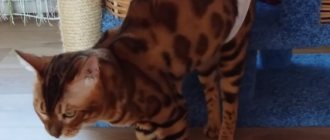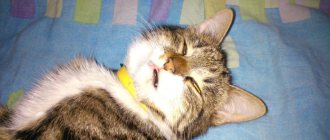How to recognize a bruise or injury to the forelimb
An injury or bruise is fairly easy to spot. With such ailments, the animal cannot step on a limb. When trying to touch a sore spot, the cat will remove its paw.
Cat with an injured paw
Animals that are constantly in an active state often suffer bruises on their limbs. Main signs of damage:
- the limb at the site of the injury begins to swell;
- hematoma, which manifests itself even through the fur;
- there are no visible wounds on the injured paw;
- the paw is in its natural state;
- joints are movable;
- the injured area is slightly warmer to the touch than other areas of the body;
- the animal constantly licks the injured limb.
Cat with a bruised front paw
A fracture, unlike a bruise, should be taken much more seriously. Its signs are easier to identify, even without medical education:
- unnatural shape of the damaged paw;
- a broken bone can be easily felt;
- swelling forms on the paw.
Additional Information! Bruises and fractures are characterized by a sudden onset of lameness. Such injuries can result from a simple jump on a chair or windowsill.
Pretense
Sometimes it happens that the animal has no visible injuries, but the cat still limps on its front leg. The reason in this case may simply be the nature of the animal. A pet whose paw is slightly pinched or, for example, stepped on, may be offended. In this case, the cat, even if it does not feel any discomfort in its paw, begins to limping demonstratively only in order to express its indignation to its owners.
If the lameness is simply emotional, there will most likely be no damage to the animal's paw. Moreover, after a couple of hours the cat will get tired of playing, and he will stop limping.
Reasons why a cat is limping on its front leg
The cat is limping on its hind leg with no visible damage.
In addition to injuries, some diseases also cause lameness.
Joint diseases
Joints may hurt due to calicivirus infection. The course of this disease was observed in detail in adult cats and kittens. And it has been proven that this cat cold often causes a virus to appear in the tissues of the joints, as a result of which the pet can begin to limp.
Infections
Mycoplasmosis and chlamydia in rare cases can cause lameness. In this case, the infection affects all the limbs of the animal, so it will limp on all limbs. Painful sensations appear due to infectious inflammation.
Chlamydia is often the cause of lameness
Bone tumor
Cancer, although rare, is a very dangerous disease. It is characterized by the appearance of multiple metastases throughout the animal’s body, which can result in lameness.
Arthritis and arthrosis
Arthritis is an inflammation of the joints that is common in older cats. This is an inflammatory disease that occurs as a result of pathological changes in the joints. With it, an animal at rest does not feel pain, but when walking and, especially running, the joints begin to ache. Arthritis can be identified by lack of appetite, weakness and elevated body temperature.
The main factors for its appearance:
- heredity;
- a sedentary lifestyle typical of neutered cats;
- improper diet;
- infections.
Additional Information! Poor environmental conditions may be among the causes of arthrosis. It has a negative impact not only on people, but also on animals.
Lameness after injection
Sometimes the injection may cause pain. This happens if the needle has hit a nerve, or if the medication you are taking has side effects. Usually the pain in the paw goes away after a few days.
Age-related changes
The musculoskeletal system of cats, like that of people, works worse with age. As a result, the bones become brittle and the joints wear out. This is an extremely rare occurrence, but if lameness appears in an older cat, it is worth considering this cause.
Paw problems in older cats
Back or brain injury
Sometimes pain in a limb does not always mean that the problem lies there. As a result of injury to the lumbar back or brain, the animal may begin to limp. It is likely that a nerve may be pinched, causing the animal to experience discomfort when moving.
Lack of microelements
Lameness in the limbs can occur due to a lack of useful elements, especially calcium. It is unlikely that the animal will eat so poorly, however, this reason is typical for pregnant or lactating cats, because all the nutrients they receive go to feed the offspring.
Elbow dysplasia
The disease is typical for purebred cats. It appears at a young age and progresses over the years, resulting in the cat limping on one or both front legs.
Osteomyelitis
A disease characteristic of Persian cats. With it, partial destruction of bone tissue occurs. This disease is common in young animals and can affect any limb.
Symptoms of pathology
Most often, limb paralysis does not occur immediately. First, signs of motor dysfunction appear, which is why the pet does not immediately lose control of its legs, but gradually. Veterinarians recommend not to hesitate to contact the clinic
if the following symptoms appear:
- The cat begins to hesitantly step on the pads. Before he steps, he tries to find his balance.
- Dragging appears when the cat is unable to move its paws: it drags them without lifting them off the floor. It seems that the pet is sneaking up on the prey during the hunt. The next stage will be paralysis of the lower or lateral part of the body.
- The cat's limbs move greatly when walking or standing.
- Constant back squatting. This often occurs in older individuals over 10 years of age.
- Severe swelling in the pelvic cavity due to bites from dogs or other cats, trauma, problems with internal organs or the lower part of the spine.
- General loss of mobility even in a young animal. The cat prefers the opportunity to lie down and relax to games.
The appearance of one or more symptoms becomes a reason to contact a veterinary hospital. Delay in consultation may result in paralysis of part of the body.
The only non-dangerous situation is a wobbling gait in small kittens. This is a natural reason, it is explained by the weakness of muscle tissue at a young age. This goes away over time and does not require therapy.
First aid
The cat has a swollen paw and is limping: what to do?
First of all, if a bruise is detected, the animal should be calmed. Then apply ice or a cold object to the sore spot. If the pet has a fracture, then the paw must be fixed and sent to an animal clinic. Here the doctor will take an x-ray and decide on further treatment.
Cat with broken paws
Important! You should not give your cat medications from your home medicine cabinet. They help humans, but can cause serious harm to animals.
Elbow dysplasia
This disease occurs in both young and old cats. Unfortunately, purebred animals are especially susceptible to it. Cattery owners often use this method of breeding expensive cats as inbreeding. In this case, kittens are born with pronounced breed characteristics. However, inbreeding significantly increases the risk of offspring developing hereditary diseases. One of these ailments is elbow dysplasia.
Signs of this disease can appear in a pet at a very early age. However, lameness in a cat with this problem becomes most noticeable at 2-3 years of age. Of course, such animals should not be allowed to breed. Also, the cat should definitely be taken to the veterinarian.
Like arthrosis, it is unlikely that it will be possible to cure dysplasia in a pet. However, the doctor will still choose a treatment regimen that will make the cat’s life more comfortable. The main symptoms of this disease in cats, in addition to lameness, are:
- crunching sounds when moving;
- X-shaped curvature of the limbs;
- stiffness of movement when standing up.
Diagnosis of cat lameness
Why does a cat walk past the litter box: the main reasons and what to do
In any case, if you find problems with your paw, you should definitely see a doctor. At the appointment, the veterinarian will need to perform the following diagnostic steps:
- A survey of the cat's owner to determine how the animal was injured or the possibility of other symptoms.
- Visual inspection. The veterinarian determines the sore spot, possible external signs of lameness, and also looks at how the pet stands and moves.
- Neurological examination to exclude the possibility of damage to the nervous system and brain.
- X-ray. It will allow you to see the causes of lameness inside the limb.
Additionally, urine, stool and blood tests, ultrasound and MRI may be needed. The doctor begins to treat the animal if the cause of the pain in the paw is discovered.
Examination by a veterinarian
In what cases should a cat be taken to the veterinarian?
When is specialist help needed? When the animal exhibits at least one of the following symptoms:
- the cat cannot walk at all or moves with great difficulty;
- when you touch the paw, the pet meows and abruptly pulls it away;
- the cat does not step on its paw, tucking it in when moving.
It is also worth visiting a specialist if the cat’s lameness is accompanied by loss of appetite, high fever, increased fatigue, lethargy or aggression. These are already very alarming symptoms.
Treatment of lameness
There are only two ways to treat cat paws—medication and surgery.
Drug therapy
When arthrosis is detected, the animal needs to restore the integrity of the cartilage, for which special medications are prescribed. In the event that the cause of the pain is not clear, he is prescribed rest and anti-inflammatory drugs, which are taken in the form of tablets or injections in the thigh.
Important! In case of infectious diseases, it is first necessary to eliminate the cause of their occurrence. For this purpose, treatment with antibiotics together with anti-inflammatory drugs is prescribed.
Surgical intervention
With chronic types of arthrosis or osteochondrosis, pain is constantly present. If the lameness becomes severe, surgery may be required, the worst result of which will be the replacement of the affected limb with a prosthesis. Also, the help of a surgeon is necessary if pinched nerves cannot be eliminated by other means.
Osteomyelitis in cats
If a domestic cat is limping on its front leg, this may also indicate that it has developed this dangerous disease. The disease in this case also manifests itself gradually. Osteomyelitis is a disease associated with bone necrosis, accompanied by a purulent-inflammatory process.
Most often, this unpleasant disease occurs in cats under the age of 2 years. At the same time, pets of the Persian breed are considered the most susceptible to it. Veterinarians explain this by hereditary predisposition. Osteomyelitis is usually treated comprehensively - through surgery, as well as medications.











